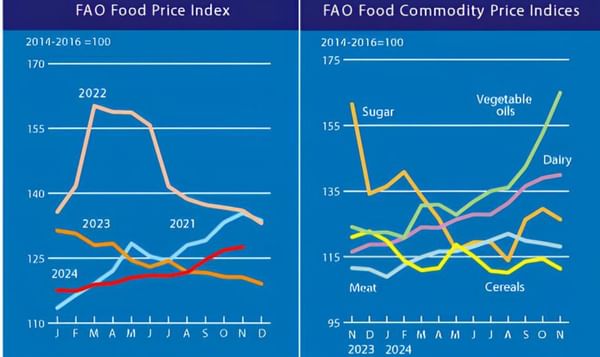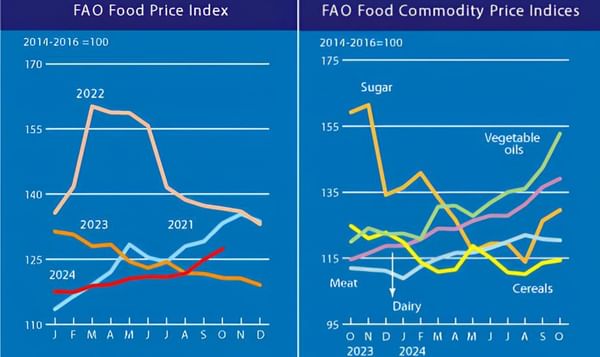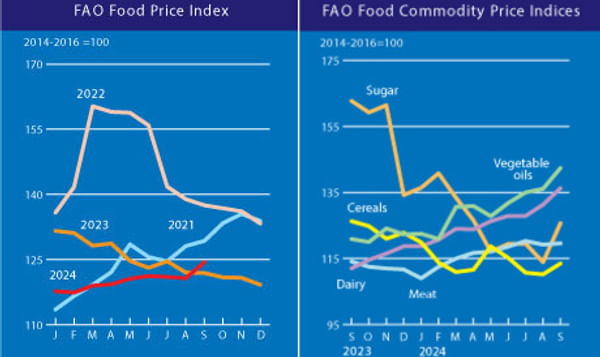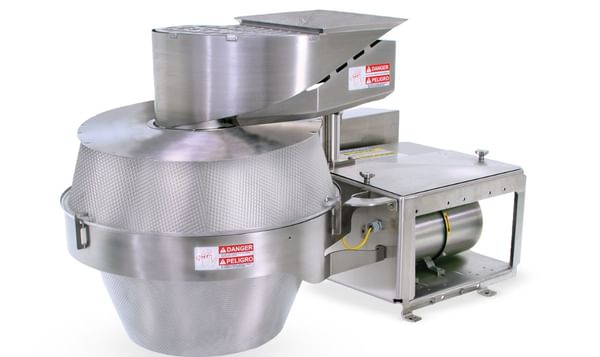The FAO Food Price Index (FFPI) averaged 178.4 points in September 2017, up 1.4 points (0.8 percent) from August and 7.4 points (4.3 percent) above September 2016.
FAO Food Price Index up slightly in September

The FAO Food Price Index (FFPI) averaged 178.4 points in September 2017, up 1.4 points (0.8 percent) from August and 7.4 points (4.3 percent) above September 2016. Firmer prices in the vegetable oil and dairy sectors were behind the small month-on-month rise in the value of the FFPI.
The FAO Cereal Price Index averaged 152.2 points in September, down 1.6 points (1.0 percent) from August. While the Index declined for the second consecutive month, it remained 8 percent above the corresponding month last year. Maize prices fell in September, reacting to ample supplies in South America and harvest pressure in the northern hemisphere. Wheat values were also weaker, with continued upgrading of this year’s harvest in the Russian Federation a major factor. By contrast, seasonally tight availabilities of fragrant rice and firm demand for higher quality Indica supplies kept international rice prices firm over the month.
The FAO Vegetable Oil Price Index averaged 171.9 points in September, compared to 164.4 in August – rising for the second consecutive month and marking a 7-month high. The gain was primarily driven by palm oil, prices of which strengthened amid lower than anticipated production in Southeast Asia and firm import demand fuelled by low inventory levels in main importing countries. International soy oil prices also rose, mainly reflecting concerns about a slow start in plantings in South America, though the price increases were capped by larger than expected harvest estimates in the United States. Continued firmness in rapeseed and sunflower oil values also contributed to the rise in the index.
The FAO Dairy Price Index averaged 224.2 points in September, up 4.5 points (2.1 percent) from the previous month. At this level, the index was 27.4 percent higher than the corresponding period last year, but still 18.6 percent below its peak reached in February 2014. The increase in September reflects continued supply constraints in Australia, New Zealand and the European Union, with growth in the United States remaining timid. Butter and cheese remain the dairy products in highest demand, especially in Asia. Meanwhile, international prices of Skimmed Milk Powder (SMP) and Whole Milk Powder (WMP) fell due to limited buying interests.
The FAO Meat Price Index averaged 173.2 points in September, unchanged from August but up 9.5 points (5.8 percent) compared to the same period last year. In September, a rise in the international prices of ovine meat countered a decline in pig meat quotations, while those of bovine and poultry meat remained largely unchanged. In the case of ovine meat, prices rose, buoyed by strong import demand, especially from the Middle East and South East Asia, coupled with continued overall supply constraints in Oceania. By contrast, pigmeat prices fell slightly, responding to improved supplies from Brazil. Poultry and bovine meat markets remained well supplied, keeping prices stable.
The FAO Sugar Price Index averaged 204.2 points in September, nearly unchanged from August but as much as 101 points (33 percent) below the same period last year. The rapid decline in sugar quotations since the beginning of this year reflects a continuing oversupply situation prevailing in world markets, in parallel with the slow-down in demand.
The FAO Cereal Price Index averaged 152.2 points in September, down 1.6 points (1.0 percent) from August. While the Index declined for the second consecutive month, it remained 8 percent above the corresponding month last year. Maize prices fell in September, reacting to ample supplies in South America and harvest pressure in the northern hemisphere. Wheat values were also weaker, with continued upgrading of this year’s harvest in the Russian Federation a major factor. By contrast, seasonally tight availabilities of fragrant rice and firm demand for higher quality Indica supplies kept international rice prices firm over the month.
The FAO Vegetable Oil Price Index averaged 171.9 points in September, compared to 164.4 in August – rising for the second consecutive month and marking a 7-month high. The gain was primarily driven by palm oil, prices of which strengthened amid lower than anticipated production in Southeast Asia and firm import demand fuelled by low inventory levels in main importing countries. International soy oil prices also rose, mainly reflecting concerns about a slow start in plantings in South America, though the price increases were capped by larger than expected harvest estimates in the United States. Continued firmness in rapeseed and sunflower oil values also contributed to the rise in the index.
The FAO Dairy Price Index averaged 224.2 points in September, up 4.5 points (2.1 percent) from the previous month. At this level, the index was 27.4 percent higher than the corresponding period last year, but still 18.6 percent below its peak reached in February 2014. The increase in September reflects continued supply constraints in Australia, New Zealand and the European Union, with growth in the United States remaining timid. Butter and cheese remain the dairy products in highest demand, especially in Asia. Meanwhile, international prices of Skimmed Milk Powder (SMP) and Whole Milk Powder (WMP) fell due to limited buying interests.
The FAO Meat Price Index averaged 173.2 points in September, unchanged from August but up 9.5 points (5.8 percent) compared to the same period last year. In September, a rise in the international prices of ovine meat countered a decline in pig meat quotations, while those of bovine and poultry meat remained largely unchanged. In the case of ovine meat, prices rose, buoyed by strong import demand, especially from the Middle East and South East Asia, coupled with continued overall supply constraints in Oceania. By contrast, pigmeat prices fell slightly, responding to improved supplies from Brazil. Poultry and bovine meat markets remained well supplied, keeping prices stable.
The FAO Sugar Price Index averaged 204.2 points in September, nearly unchanged from August but as much as 101 points (33 percent) below the same period last year. The rapid decline in sugar quotations since the beginning of this year reflects a continuing oversupply situation prevailing in world markets, in parallel with the slow-down in demand.
¿Te gustaría recibir noticias como esta por correo electrónico? ¡Únete y suscríbete!
Únete a nuestra Telegrama ¡Canal para actualizaciones periódicas!
Empresa Destacada
Contenido Patrocinado
Contenido Patrocinado
Contenido Patrocinado
Contenido Patrocinado
Contenido Patrocinado











